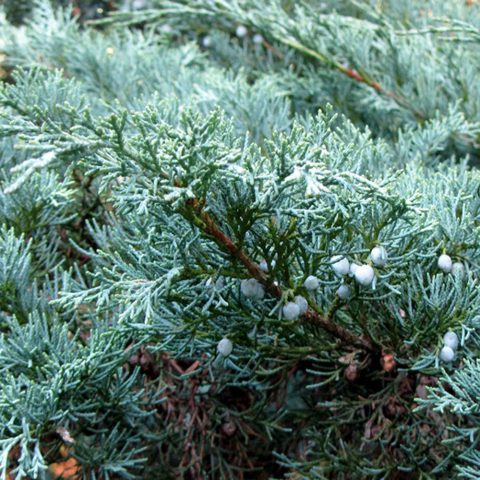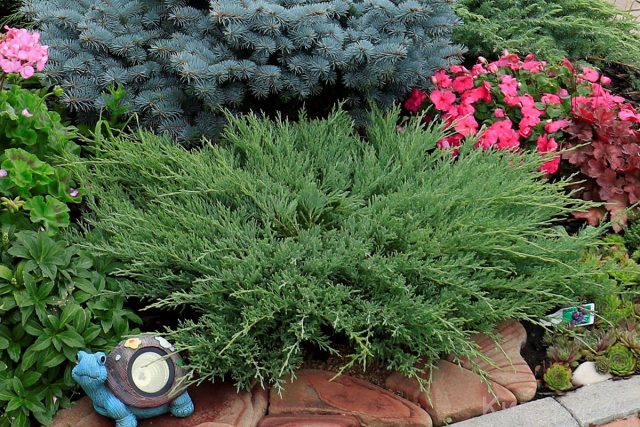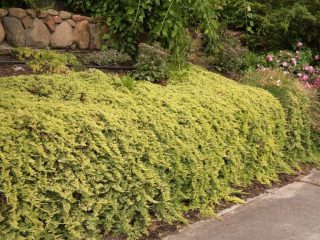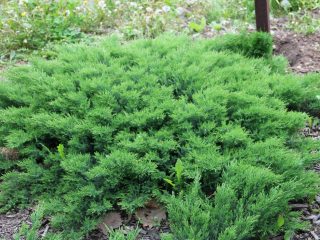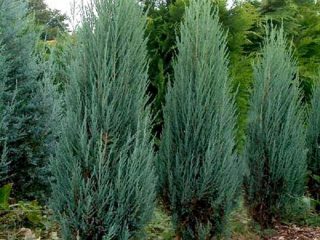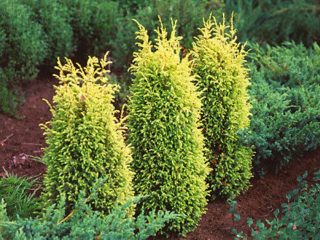Content
The homeland of the evergreen representative of the Cypress family is America, Virginia. The culture is widespread at the foot of the rocky mountains at the edges of the forest, less often along the banks of rivers and in swampy areas. Juniper Hetz - the result of crossing Chinese and Virginian junipers. The American ephedra has become the ancestor of many varieties of culture with a varied shape and color of the crown.
Description Juniper Virginiana Hetz
The evergreen hetz juniper, depending on pruning, can be in the form of a horizontal spreading shrub or an upright tree of a symmetrical conical shape. The ability to shape the desired shape gives a well-defined tall stem. Hetz is one of the representatives of the Virginian juniper of medium size, which gives a significant increase for the species. The size of an adult juniper of Virginia Khetz, without growth correction, reaches 2.5 m in height, the diameter of the crown is 2.5-3 cm.Over a year, the plant adds 23 cm in height, approximately also increases in diameter. For 9 years it grows to 1.8 m, then the growth decreases to 10 cm, at the age of 15 the plant is considered an adult.
The frost-hardy Khetz juniper is suitable for cultivation in the Central Black Earth regions, the European part of Russia. Due to its drought tolerance, the Hetz juniper is cultivated in the North Caucasus and southern regions. The plant is light-loving, tolerates planting in open areas, can grow in partial shade. Waterlogging of the soil is not shown. Does not lose its decorative effect in dry weather. Poorly tolerates drafts.
Perennial Hetz retains its habitus up to 40 years, then the lower branches begin to dry, the needles turn yellow and crumble, the juniper loses its decorative effect. Due to the good annual growth, the shrub is constantly pruned to form the crown.
Description of the Virginian juniper Hetz, shown in the photo:
- The crown is spreading, loose, the branches are horizontal, the upper part is slightly raised. Branches of medium volume, gray with a brown tint, uneven bark.
- At the initial stage of the growing season, it forms dense scaly needles, as it grows, it becomes acicular, triangular, soft, with pointed, thornless ends. The needles are dark blue, closer to the steel color. By the fall, the needles are painted in a maroon shade.
- The variety is monoecious, forms flowers only of the female type, bears fruit abundantly every year, which is considered a rarity for Cypress.
- Cones at the beginning of growth are light gray in color, ripe bluish-white, numerous, small.
Juniper Hetz in landscape design
The culture is frost-resistant, tolerates low humidity well. Shows a high degree of rooting in a new location. Due to its varietal characteristics, it is used for landscape design almost throughout Russia. Juniper Hetz is planted as a tapeworm or massively in one line. They are used for landscaping household plots, squares, recreation areas, city parks.
Juniper Virginia Hetz (pictured) is used as a foreground in a flower bed in a composition with dwarf conifers and flowering plants. Application of hetz juniper in design:
- to create an alley. Landing on both sides of the garden path is visually perceived as an alley;
- for the design of the banks of the reservoir;
- to form a hedge around the perimeter of the site;
- for designating the background a discount;
- to separate areas of the garden;
- to create an accent in rockeries and rock gardens.
The Hetz juniper planted around the gazebo will add color to the recreation area and create the feeling of a coniferous forest.
Planting and caring for the Hetz juniper
Juniper Virginia Hetz variegata prefers light, well-drained soils. The composition is neutral or slightly alkaline. The culture does not grow on salty and acidic soil. The best option for planting is sandy loam.
Seedling and planting plot preparation
Requirements for planting material for juniper juniperus virginiana Hetz:
- the seedling for breeding must be at least two years old;
- the root system is well-formed, without mechanical damage and dry areas;
- the bark is smooth, olive-colored without scratches or cracks;
- needles are required on the branches.
Before placing the Hetz variety in the designated place, the root is disinfected in a manganese solution and placed in a growth stimulator. If the root system is closed, planted without treatment.
The site is prepared a week before planting, the place is dug up, the composition is neutralized. A nutrient mixture is prepared for the seedling: peat, soil from the planting site, sand, deciduous humus. All components are mixed in equal parts. A planting hole is dug 15 cm wider than the root ball, the depth is 60 cm. Drainage from broken bricks or coarse pebbles is placed on the bottom. 1 day before planting, fill the pit to the top with water.
Landing rules
Sequencing:
- ½ part of the mixture is poured into the bottom of the pit.
- Make a hill.
- A seedling is placed in the center on a hill.
- Pour the rest of the mixture so that about 10 cm remains to the edge.
- They fill the void with wet sawdust.
- The soil is compacted and watered.
If the planting is massive, a space of 1.2 m is left between the juniper.
Watering and feeding
Juniper Hetz after planting is watered every evening for three months with a little water. If the root system was not previously dipped into a growth stimulator, the drug is added to the irrigation water. Sprinkling is carried out every morning. There are enough microelements in the nutrient mixture, they will be enough for the plant for 2 years. Then the root system will deepen, so the need for feeding will disappear.
Mulching and loosening
The near-trunk soil is mulched immediately after planting with dry leaves, peat or small tree bark. In the fall, the layer is increased, in the spring the composition is renewed. Loosening and weeding of young juniper seedlings is carried out as they grow weeds... An adult plant does not need this agricultural technique, the weed does not grow under the dense crown, and the mulch prevents the compaction of the upper soil layer.
Trimming and shaping
Up to two years of growth, the Hetz juniper is only sanitized. Dry and damaged areas are removed in the spring. The formation of the bush begins after 3-4 years. The plant is shaped and maintained every spring by pruning before sap begins to flow.
Preparing for winter
Frost-resistant juniper Hetz can withstand temperatures as low as -28 0C. For an adult plant in the fall, the mulch layer is increased by 15 cm and water-charging irrigation is carried out, this will be enough. The Shelter Young Juniper Needs:
- Seedlings spud.
- Put mulch and a layer of straw on top.
- The branches are tied and bent to the ground so that they do not break under the mass of snow.
- Cover with spruce branches from above, or polyethylene stretched over arcs.
- In winter, the juniper is covered with a layer of snow.
Reproduction
Juniper virginiana Hetz (juniperus virginiana Hetz) is bred by the following methods:
- by cuttings, the material is taken from last year's annual shoots, the length of the cuttings is 12 cm;
- layering, in the spring the shoot of the lower branch is fixed to the ground, sprinkled with soil, after 2 years they are seated;
- seeds.
The grafting method is rarely used, the juniper is a tall-growing plant, it can be formed in the form of a standard tree without grafting.
Diseases and pests
Juniper medium Hetzi Hetzii is resistant to fungal infection. The only condition for growing is that you cannot place the culture near the apple trees. Fruit trees cause rust on the crown of the ephedra.
Parasite on ephedra:
- aphid;
- juniper sawfly;
- shield.
In order to prevent the appearance and spread of pests, the shrub is treated with copper sulfate in spring and autumn.
Conclusion
Juniper Hetz is a perennial evergreen that is used for landscaping urban recreation areas and home gardens. A tall shrub is used to decorate flower beds, used in mass plantings to form a hedge. The culture is frost-resistant, tolerates drought well, and is easy to care for.
